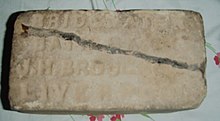Bath brick

The bath brick (also known as Patent Scouring or Flanders bricks),[1] patented in 1823 by William Champion and John Browne, was a predecessor of the scouring pad used for cleaning and polishing.
Bath bricks were made by a number of companies in the town of Bridgwater, England, from fine clay dredged from the River Parrett near Dunball.[2] The silt, which was collected from the river on either side of the Town Bridge, contained fine particles of alumina and silica.[3] It was collected from beds of brick rubble left in the rain for the salt to be washed out and then put into a "pugging mill" which was powered by a horse to be mixed, before being shaped into moulds and dried. These would be wrapped in paper and boxed for sale in England and throughout the British Empire.[4] By the end of the 19th century around 24 million bath bricks had been produced in Bridgwater for the home and international markets.[5]
The brick, similar in size to an ordinary house brick, could be used in a number of ways. A mild abrasive powder could be scraped from the brick and used as a scouring powder on floors and other surfaces. Powder could also be moistened with water for use on a cloth for polishing or as a kind of sand paper. Items such as knives might be polished directly on a wetted brick.[6]
See also
[edit]References
[edit]- ^ "070319.Bridgwater, Just Water Under the Bridge? (Not to Bath Brick Enthusiasts)". Bath Daily Photo. 18 March 2007. Retrieved 4 January 2016.
- ^ Hawkins, Desmond (1982). Avalon and Sedgemoor. Gloucester: Alan Sutton Publishing. ISBN 0-86299-016-5.
- ^ "The Bridgwater Bath Brick". Experience Somerset. Archived from the original on 10 February 2018. Retrieved 4 January 2016.
- ^ Body, Geoffrey (2013). The A-Z of Curious Somerset. The History Press. pp. 18–20. ISBN 9780752493299.
- ^ "Bath Brick". Bridgwater Town Council. Archived from the original on 4 March 2016. Retrieved 4 January 2016.
- ^ Hayes, Alan; Urquhart, Diane (2001). The Irish Women's History Reader. Psychology Press. p. 216. ISBN 9780415199148.


 French
French Deutsch
Deutsch